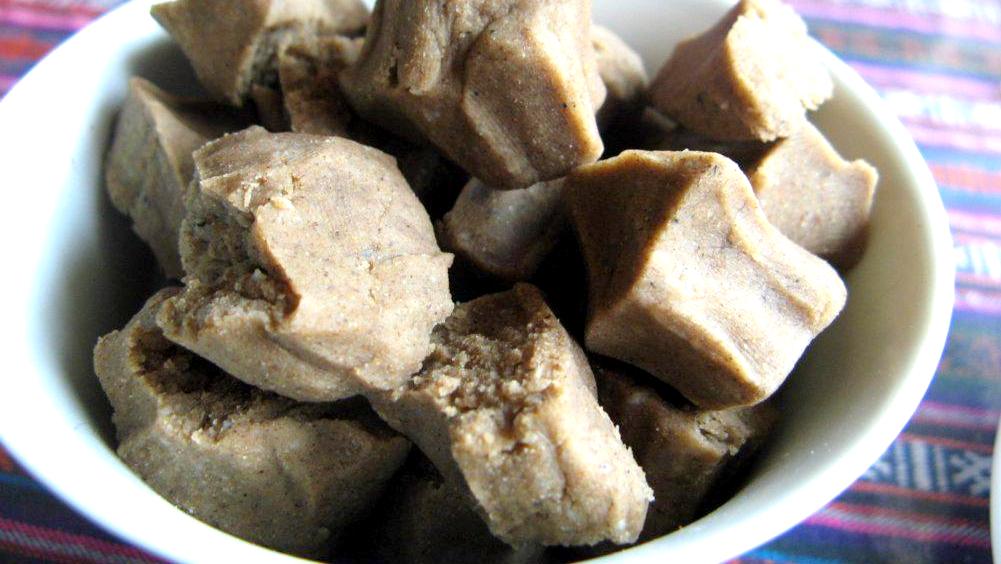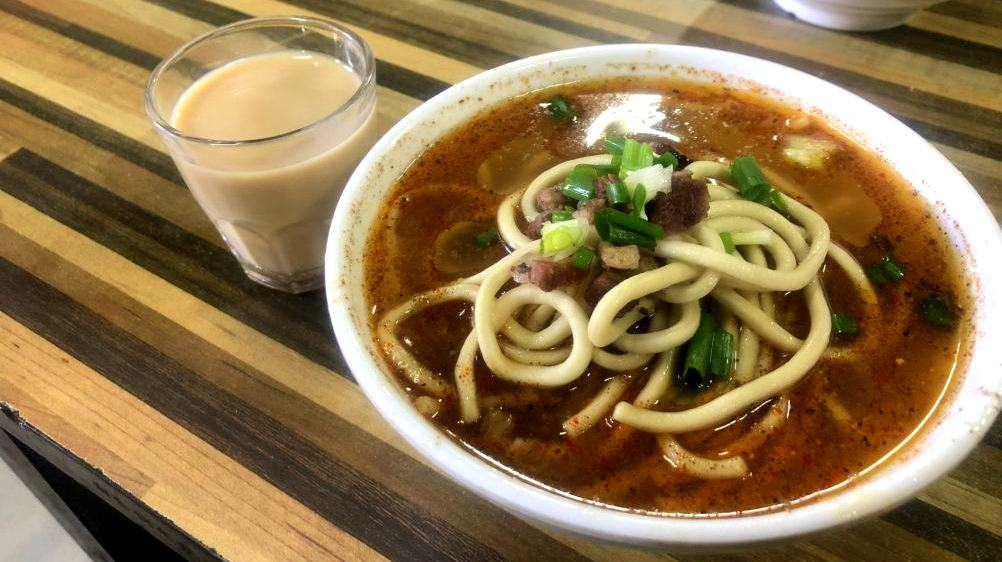Nestled amidst the grandeur of the Himalayas, Tibet is a land celebrated not only for its ethereal landscapes and spiritual essence but also for its distinctive culinary tradition. This traditional Tibetan cuisine, with its reliance on minimal yet nutrient-rich ingredients, serves as a testament to the Tibetan people's resilience and their harmonious existence with nature. Ingredients like tsampa (roasted barley flour), yak dairy, and butter tea form the backbone of this cuisine, embodying the adaptability and communal spirit of the Tibetan way of life. Each dish, whether it's the warming thukpa or the communal favorite momos, is a story of survival, a ritual of preparation and sharing that strengthens community bonds and reflects a profound connection with the earth. Tibetan cuisine is thus not merely about sustenance but is a rich, cultural tapestry that weaves together tales of endurance, unity, and the deep, spiritual relationship with their imposing yet nurturing Himalayan home.

At Druk Holidays, we offer an authentic journey into the heart of Tibetan cuisine. Our tours are designed to give you a true taste of Tibet, from the hearty thukpas and steamed momos to the energizing butter tea. With our local guides, you'll explore traditional markets, participate in cooking classes, and dine in local homes, ensuring a genuine experience of Tibet's culinary traditions. Join us to savor the simple yet profound flavors of Tibet, making your trip an unforgettable exploration of culture and cuisine.
The Essence of Tibetan Cuisine
Tibetan cuisine is deeply rooted in the region's geography, climate, and Buddhist culture, reflecting a lifestyle adapted to high altitudes and harsh conditions. Here are key points that capture the essence of Tibetan cuisine, along with explanations:
-
Simplicity and Nourishment: Tibetan dishes are known for their simplicity, focusing on a few staple ingredients that provide high energy and nutrients essential for surviving the cold, high-altitude environment. This simplicity reflects the Tibetan approach to life, emphasizing sustenance and practicality.
-
Tsampa (Roasted Barley Flour): Tsampa is the cornerstone of Tibetan cuisine, used as the base for many meals. It is versatile, nutritious, and can be easily carried by nomads or travelers. Mixed with butter tea, it forms a staple diet that sustains the Tibetan people through the harsh winters.

-
Yak Products: Given the limited agricultural possibilities, yak meat, milk, butter, and cheese are essential to Tibetan cuisine, providing protein, fat, and other nutrients. Yaks are integral to Tibetan life, not just as food sources but also as beasts of burden.
-
Butter Tea: A unique feature of Tibetan cuisine, butter tea blends black tea, yak butter, and salt. It serves as a vital source of energy and warmth in the cold climate, consumed multiple times a day for hydration and calories.
-
Use of High-Altitude Crops and Vegetables: Due to the challenging growing conditions, the vegetables and crops that thrive in Tibet are those adapted to high altitudes, such as potatoes, radishes, and barley. These ingredients form the backbone of many Tibetan meals, showcasing the adaptability of Tibetan agriculture.
-
Influence of Buddhism: Buddhist principles significantly influence Tibetan cuisine, emphasizing vegetarianism and the ethical treatment of animals. While meat is consumed, it is done with respect and acknowledgment of the animals' sacrifice.
-
Communal Eating Practices: Meals in Tibetan culture are often communal, reflecting the importance of family and community. Sharing food is a sign of hospitality and kinship, reinforcing social bonds.
-
Seasonal and Festive Foods: Tibetan cuisine changes with the seasons and includes special dishes for festivals and religious ceremonies. This reflects the deep connection between Tibetan culture, their environment, and their calendar of spiritual observances.
-
Adaptation and Resilience: The evolution of Tibetan cuisine shows the resilience of the Tibetan people, adapting their dietary practices to the limitations and opportunities of their environment. This adaptability is a testament to their resourcefulness and deep connection to their land.
Tibetan cuisine, with its rich flavors and deep cultural significance, offers a window into the lives of the Tibetan people, reflecting their history, spirituality, and unyielding resilience.
Iconic Dishes of Tibetan Cuisine
Tibetan cuisine, characterized by its simplicity, nourishment, and deep-rooted cultural significance, boasts several iconic dishes that are essential to the Tibetan way of life. These dishes not only offer a glimpse into the daily lives of Tibetans but also embody the essence of the region's culinary tradition. Here's a look at some of the most iconic dishes of Tibetan cuisine:
-
Momos: These are Tibetan dumplings that have gained popularity worldwide. Filled with either vegetables or meat, momos are steamed or sometimes fried. They are typically served with a spicy chutney or soup and are a favorite snack or meal at any time of day.
-
Tsampa: Tsampa, roasted barley flour, is perhaps the most quintessential Tibetan food. It is incredibly versatile and can be mixed with butter tea, water, or milk to form a dough-like paste. Tsampa is eaten daily by many Tibetans and is a staple food that provides essential nutrients and energy.
-
Thukpa: A hearty noodle soup that is particularly comforting in cold weather. Thukpa includes vegetables and meat (often yak or mutton) in a flavorful broth, seasoned with local herbs and spices. It can be found in various forms across Tibet and the Himalayan region.

-
Butter Tea (Po Cha): This traditional drink is made by churning tea, salt, and yak butter. Rich and calorie-dense, butter tea is an essential source of energy and warmth in the high-altitude climate of Tibet. It's consumed several times a day and plays a key role in Tibetan hospitality.
-
Tingmo (Tibetan Steamed Bread): A fluffy, steamed bread that's often served as an accompaniment to main dishes. Tingmo is yeast-leavened and has a slightly sweet taste. It's used to soak up sauces or broths, making it a staple in Tibetan meals.
-
Yak Cheese (Chhurpi): Made from the milk of yaks, this cheese ranges from soft and spreadable to hard and chewy. It's an important source of protein in the Tibetan diet and can be eaten as a snack or used in various dishes.
-
Drokpa Katsa (Tibetan Dried Beef): A traditional dried meat, often made from yak or sheep, that is spiced and then air-dried to preserve it. Drokpa Katsa is a common ingredient in Tibetan meals, providing a rich source of protein.
-
Barley Beer (Chang): A traditional alcoholic beverage made from fermented barley. Chang is a popular drink in Tibetan social and ceremonial occasions, offering a mild, slightly sweet flavor.
These dishes are more than just food; they are a celebration of Tibetan culture, resilience, and the ingenuity of its people in creating a rich culinary heritage from the rugged Himalayan landscape. Each dish tells a story of tradition, community, and the deep connection Tibetans have with their environment.
The Flavor Palette
The flavor palette of Tibetan cuisine is shaped by the geographical and cultural landscape of Tibet, embodying a combination of hearty, warming, and subtly complex tastes. Despite its simplicity, the cuisine offers a distinctive blend of flavors that reflects the necessities of high-altitude living and the influences of neighboring countries. Here’s an overview of the key elements that define the flavor palette of Tibetan cuisine:
-
Savory and Rich: The use of yak butter and cheese adds a deep, rich savory quality to many Tibetan dishes, including the iconic butter tea and various soups and broths. This richness is a hallmark of Tibetan flavors, providing essential energy and warmth.
-
Earthy: Barley, as the staple grain, imparts an earthy base to the cuisine, most notably in tsampa and barley-based breads. This earthiness is a comforting constant in the diet, grounding Tibetan food in the landscape from which it originates.
-
Mildly Spiced: Unlike the cuisines of its South Asian neighbors, Tibetan cuisine tends to be more mildly spiced. However, the incorporation of garlic, ginger, and occasionally Sichuan peppercorns introduces a gentle heat and complexity, enhancing dishes without overwhelming them.
-
Sour and Fermented: Fermented products like yak cheese and yogurt introduce a sour note that balances the richness of the butter and meat. This sourness adds a refreshing contrast, especially in dishes that might otherwise feel heavy.
-
Umami: The use of dried meats and the natural flavors of yak meat contribute an umami depth, enriching soups, stews, and other meat-based dishes with a satisfying savoriness that is both subtle and complex.
-
Herbal and Fresh: The inclusion of locally available herbs and the occasional green vegetable adds freshness and a light, herbal quality to the cuisine, offering a hint of brightness amid the richer, more grounding flavors.
-
Salty: Given the inclusion of salt in butter tea and many other dishes, there is a noticeable salty character to Tibetan cuisine. This not only enhances the flavors but also helps with hydration at high altitudes, where the risk of dehydration is greater.
The flavor palette of Tibetan cuisine is a testament to the ingenuity of its people, who have developed a culinary tradition that is not only nourishing and suited to their environment but also rich in taste and tradition. Through a delicate balance of savory richness, mild spices, and the natural flavors of their local ingredients, Tibetans have created a unique and enduring food culture that offers a window into their way of life.
Cultural Significance and Communal Dining
The cultural significance of Tibetan cuisine extends far beyond mere sustenance, deeply intertwined with the spiritual, communal, and environmental ethos of Tibetan life. Food in Tibet is a reflection of the people's adaptability, resourcefulness, and profound connection to their surroundings, embodying the essence of Tibetan culture in every bite. Communal dining, particularly, plays a pivotal role in reinforcing social bonds and cultural identity, making meals a shared experience that is rich in tradition and communal harmony.
Cultural Significance
-
Spiritual Connection: Many Tibetan dishes and eating habits are influenced by Buddhist principles, emphasizing compassion and mindfulness. The act of preparing and consuming food is often seen as a spiritual practice, with certain foods and rituals associated with religious festivals and ceremonies. This spiritual connection underscores the respect for life and the environment, central to Tibetan cuisine.
-
Harmony with Nature: Tibetan cuisine reflects a deep-seated harmony with the natural environment, utilizing what the rugged landscape can sustainably provide. Ingredients like barley, yak meat, and dairy products are staples not only due to their availability but also because they symbolize the Tibetan people's adaptation to their high-altitude homeland. This harmony with nature is a fundamental aspect of Tibetan culture, mirrored in their dietary practices.
-
Cultural Preservation: Food serves as a vessel for cultural preservation, passing down traditions, recipes, and techniques from generation to generation. In a region where oral histories and traditions are paramount, cuisine becomes a tangible representation of Tibetan heritage and identity, celebrating the resilience and beauty of their culture despite external challenges.
Communal Dining
-
Social Cohesion: Meals in Tibet are typically communal affairs, where families and friends gather around a shared table. This practice reinforces social bonds and a sense of community, embodying the Tibetan values of hospitality, generosity, and interdependence.
-
Sharing and Hospitality: Sharing food is a fundamental expression of Tibetan hospitality. The act of offering food to guests, including the traditional butter tea, is imbued with significance, symbolizing welcome, respect, and friendship. In Tibetan culture, to share a meal is to share a part of oneself, fostering connections and mutual understanding.
-
Communal Preparation: The preparation of meals is often a communal activity, where the process of cooking becomes an opportunity for social interaction and cooperation. This collective effort in meal preparation strengthens community ties, with each member contributing to the task, embodying the communal spirit that pervades Tibetan society.
-
Festivals and Celebrations: Food plays a central role in Tibetan festivals and celebrations, with specific dishes prepared to mark these occasions. These communal feasts are times of joy and reaffirmation of cultural and religious identities, where food serves as a medium for expression and celebration of Tibetan life and its cyclical nature.
The cultural significance of Tibetan cuisine and the practice of communal dining are reflective of a society that values spiritual depth, communal harmony, and a profound connection with the environment. In Tibet, to eat is not just to nourish the body but to nurture the soul, strengthen community bonds, and honor the sacredness of life and nature.
Tibetan cuisine, with its rich tapestry of flavors, ingredients, and communal dining practices, stands as a profound expression of Tibetan culture, spirituality, and resilience. It transcends the mere act of eating, weaving together the threads of tradition, environmental harmony, and social cohesion into a vibrant culinary tradition that offers insights into the heart of Tibetan life. Through its simple yet nourishing dishes, the communal joy of shared meals, and the deep cultural significance imbued in every bite, Tibetan food culture embodies the essence of a people deeply connected to their land, their beliefs, and each other. As such, exploring Tibetan cuisine is not just a journey of taste but a path to understanding the spirit of Tibet, inviting us to appreciate the ways in which food can connect us to places, histories, and communities far beyond our own.
FAQs of the Savoring Tibet: An Introduction to Traditional Tibetan Cuisine
Q: What is tsampa and why is it so important in Tibetan cuisine?
A: Tsampa is roasted barley flour, a staple of Tibetan cuisine due to its versatility, nutritional value, and ease of preparation. It's important because it provides a reliable source of energy in the harsh, high-altitude conditions of Tibet and can be easily carried by nomads or travelers. Tsampa symbolizes Tibetan resilience and adaptability, forming the basis of many traditional dishes.
Q: Can I find vegetarian options in Tibetan cuisine?
A: Yes, there are several vegetarian options in Tibetan cuisine, reflecting the influence of Buddhist principles. Dishes like vegetable momos, tsampa porridge, and thukpa (noodle soup) can be prepared without meat, offering flavorful and nourishing choices for vegetarians.
Q: What makes Tibetan butter tea unique?
A: Tibetan butter tea, or Po Cha, is unique because it combines black tea, salt, and yak butter into a rich, energizing drink that's essential for survival in the cold, high-altitude climate of Tibet. Its distinctive taste and the ritual of drinking it multiple times a day reflect its cultural and nutritional importance.
Q: Are there any Tibetan dishes suitable for special diets, such as gluten-free or dairy-free?
A: While many Tibetan dishes are based on barley (which contains gluten) and yak dairy, there are options for those on special diets. For a gluten-free diet, dishes like yak meat, vegetable stews, and certain types of noodle soups can be suitable. For a dairy-free diet, look for meat or vegetable dishes that do not use butter or cheese, and enjoy herbal teas instead of butter tea.
Q: How do Tibetan eating habits reflect their environment and lifestyle?
A: Tibetan eating habits are deeply influenced by the high-altitude environment and nomadic lifestyle. The reliance on high-energy, nutrient-dense foods like tsampa, yak dairy, and meat helps Tibetans withstand the cold and sustain their energy. The communal aspect of dining reflects the importance of community and cooperation in surviving and thriving in such a challenging landscape.
Q: What are some must-try dishes for someone new to Tibetan cuisine?
A: For those new to Tibetan cuisine, must-try dishes include momos (dumplings), thukpa (noodle soup), and butter tea for a taste of the staple flavors. Also, trying tsampa in one of its various forms, whether as porridge or mixed with tea, provides insight into the traditional Tibetan diet.
Q: How does Tibetan cuisine differ from that of its neighbors, like Chinese or Indian cuisines?
A: Tibetan cuisine differs from its neighbors in its simplicity and reliance on a smaller variety of ingredients, reflecting the limited agricultural possibilities of its high-altitude terrain. While it shares some spices and influences with Chinese and Indian cuisines, Tibetan food tends to be less spicy and more focused on the natural flavors of its primary ingredients like barley, yak meat, and dairy.


